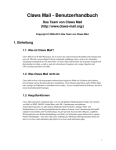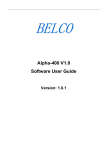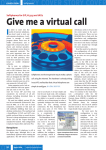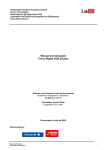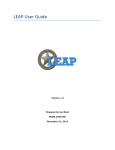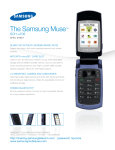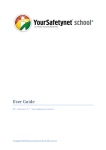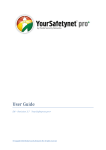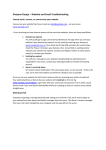Download FLEXIBLE CLAWS - Linux Magazine
Transcript
LINUXUSER
Claws Mail
Customize your mail environment with the light and powerful Claws Mail
FLEXIBLE CLAWS
Sharpen your claws on this powerful and highly configurable email client. BY PAUL MANGAN
C
laws Mail [1] started in early
2001 as Sylpheed-Claws, the development version of Sylpheed
[2]. Sylpheed-Claws provided a testbed
for a handful of enthusiastic Sylpheed
contributors and users to test patches.
Because many stable and useful features
were not finding their way into Sylpheed, Sylpheed-Claws evolved on its
own and was later renamed Claws Mail.
A small team of enthusiastic programmers continues to develop Claws Mail,
which has grown into a robust, userfriendly email client.
Claws Mail is a standards-compliant,
desktop-neutral email client and newsreader with a GTK+ interface [3] released under the GPL license. This lightweight mail reader is highly configurable
and offers some unique and powerful
customization features.
Claws Mail provides message filtering,
as well as templates, tags, support for
GnuPG, RSS feed reading, HTML rendering, calendaring, and more.
Getting Started
When you run Claws Mail for the first
time, the setup wizard provides a short
series of dialogs for setting up a POP,
IMAP, or Local account. If you have previously used Sylpheed, the wizard will
import your settings.
The wizard also includes a special
Template feature (described later in this
article) that system administrators can
use for rapid deployment.
Users will recognize the default look
of the main window (Figure 1), which is
fairly typical for email clients. The menu
bar at the top displays Claws Mail functions. Folders are shown in a column on
the left side; the message list appears in
the top half of the screen above the current message, and the QuickSearch bar
resides beneath the messages. (Claws
Mail also offers four other layouts to suit
different tastes and screen sizes.)
Toolbar
The default toolbar layout allows quick
access to all of the common operations,
such as fetching, sending, composing,
forwarding, and replying to messages.
The status bar, which runs along the
bottom of the window, shows information about currently running processes,
such as mail retrieval and filtering. Buttons for switching between online and
offline modes, as well as an account
selector, are on the right, along with an
attachment column that lets users easily
access message attachments.
LennyLT, photocase.com
78
ISSUE 90
Claws Mail
LINUXUSER
Examples of Actions
This action decodes uuencoded messages with the xdeview decoder. If an
encoded file is split into multiple messages, the action decodes them all:
Menu Name: UUdeview
Command Line: xdeview %F&
This action pipes the Subject header
value to a script:
Menu Name: Get Subject
Command Line: grep "^Subject:U
\ " %f | cut -d\ -f 2-| U
script.sh
This action performs a whois lookup on
the selected text
Menu Name: whois
Command Line: | whois '%s'
Figure 1: The Claws Mail Main Window.
To fetch new messages, click the Get
Mail button on the toolbar. Claws lets
you check incoming messages for spam
with one of the anti-spam plugins, and
you can filter and sort the messages into
subfolders.
If you would rather not click a button
to check your mail, you can configure
Claws to fetch your messages automatically. Use one of the notification plugins
to configure automatic notification if a
new messages arrives. The Claws command interface also lets you execute an
arbitrary command when a message arrives, thus providing unlimited options
for custom processing.
Composing
Composing a new message is as simple as clicking the Compose button
on the toolbar. The message composer is
equipped with spell
checking, wrapping, and
an undo feature. Actions
and templates (described
later in this article) provide additional possibilities for creating and processing messages. Claws
also offers a variety of privacy options, as well as a
return receipt feature and
priority settings.
You can use an external editor to
compose messages and insert text files
directly into the body of a message.
Configuring Claws Mail
Claws Mail offers a number of options
for configuring preferences and customizing the interface. The Account Preferences dialog lets the user define basic information such as email addresses, signatures, incoming and outgoing server
names, and ports. You can also configure
security parameters, such as SSL settings, SMTP authentication options, and
GnuPG keys.
The Common Preferences dialog offers
other configuration options, with which
you can choose to use an external pro-
gram to retrieve mail, configure colors
and fonts, select an icon theme, customize the toolbars, set up external applications such as a web browser, configure
plugins, and much more.
Each folder also has a smaller set of
options, known as Properties, that overrule preferences set elsewhere. This feature is particularly useful if you use filtering to organize a large collection of
messages into many folders. A folder can
be associated with a default template,
default dictionary, or a default account.
Filtering
Claws Mail comes with a filtering engine
that enables matching based on any part
of a received message. You can filter
Listing 1: A Reply Template
01 On %date
02 %from wrote:
03
04 %quoted_msg_no_sig
05
06 %cursor
07
08 Regards
09
10 Paul
11
12 --
Figure 2: The Filtering Condition window lets you specify
filtering criteria.
MAY 2008
13 |p{fortune}
ISSUE 90
79
LINUXUSER
Claws Mail
messages as they arrive or later. A filtering rule consists of a condition or several
conditions that a message must match
(Figure 2), and one or more actions,
which are operations that are carried out
on a matching message. A message can,
for example, be matched by any header,
any phrase in the body, an attachment
type, a color label, whether the address
is found in the address book, and so on.
Actions
Actions extend the possibilities of Claws
Mail, enabling the full power of the Unix
command line for processing mail. A
user can decode uuencoded messages,
reformat message text using external
tools such as Par, or pass text selections
to external tools – the only limit is the
user’s imagination.
The actions that are configured by
the user are accessible from the /Tools/
Actions/... menus of both the main and
Compose windows. See the box titled
“Examples of Actions” for a sample of
some Claws Mail actions.
Processing
Claws also includes a feature called
processing that is similar to filtering.
Processing rules are attached to a folder
and can be run automatically when entering the folder.
Templates
The Claws Mail’s template feature lets
you predefine templates for faster and
easier composition. You can use templates to fill the message headers or
body with static or dynamic content.
This predefined content can include
symbols and settings for date elements,
tags, dictionaries, account properties,
and information held in the address
book. Commands within templates let
you automatically insert files or program
output into a message.
The reply template shown in Listing 1
shows a familiar example. This template
resembles the standard introduction that
often accompanies a
message reply. Claws
Mail offers almost
total flexibility to customize the text and
format. In this case,
the reply includes the
name of the respondent (Regards, Paul)
as well as a random
Unix-style fortune at
the end of the message.
Figure 3: Manage your contacts with the Claws Mail address book.
Address Book
The Claws Mail address book holds information about contacts (Figure 3). The
user can configure a custom attributes
list, allowing quick definition of important fields.
The data held in the address book can
be used for automatic address completion in the Compose window. Address
book data can be used with anti-spam
plugins and whitelisting tools.
Setup Wizard for Sys
Admins
System administrators can create a wizard configuration template with the correct values entered in the setup wizard,
so users only need to enter their passwords. Using the configuration template, the system administrator can define the server addresses, add LDAP
servers or people to the address book,
add filtering rules, and load plugins.
To set up a configuration template:
1. Start Claws Mail with a user who does
not have a ~/.claws-mail directory,
click through the wizard without entering any settings, and then use the
Save button to exit the wizard.
Changing to Claws Mail
Claws Mail uses MH mailboxes, which
means it can share mailboxes with other
MUAs, such as Mutt. Claws also comes
with support for the MBOX format. The
Tools page of the Claws Mail website
provides various scripts for converting
mailboxes, address books, and filtering
rules from other email applications.
4. Delete both ~/.claws-mail/accountrc
and ~/.claws-mail/folderlist.xml, then
recursively copy the .claws-mail directory to /etc/skel/. If Claws Mail will use
MH folders, then also copy the Mail
directory to /etc/skel/. Then chown
both these directories in /etc/skel/ to
root:root.
ISSUE 90
QuickSearch
Claws Mail offers other useful features,
such as the powerful QuickSearch tool,
which allows searching through folders
and sub-folders based on any criteria.
QuickSearch can search in standard
headers, but it also has an Extended
mode, which enlists the full power of
the filtering engine.
Conclusion
Claws also supports user-defined hotkeys and provides good mailing list support. Several operations are available
from the command line that allow interaction with external applications, such
as web browsers or file managers. More
than 20 plugins support features such as
RSS reading, PDF display, and personal
and public calendaring.
If you like a lot of control over your
email, and you’re looking for a powerful
application that is light on resources,
give Claws Mail a try. ■
2. Quit Claws Mail.
3. Edit the newly created wizard template file ~/.claws-mail/accountrc.tmpl
and save it. The template file is fully
commented with instructions and
details about each entry.
80
With the address book, you also can
pre-fill fields used in templates. Reading
and writing to LDAP servers and vCards
is supported, and jPilot synchronization
is supported.
MAY 2008
INFO
[1] Claws Mail:
http://www.claws-mail.org
[2] Sylpheed:
http://sylpheed.sraoss.jp/en/
[3] GTK+, the GIMP Tool Kit:
http://www.gtk.org
[4] Claws Mail User Manual: http://www.
claws-mail.org/documentation.php
[5] Claws Mail plugins: http://www.
claws-mail.org/plugins.php
[6] Claws Mail themes: http://www.
claws-mail.org/themes.php





